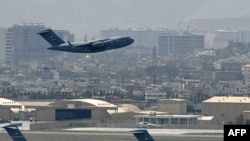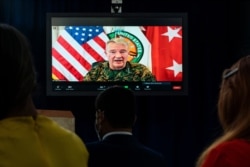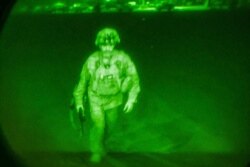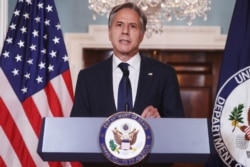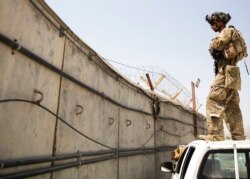Almost 20 years after the United States sent forces into Afghanistan to go after the terrorists who planned the September 11, 2001, attacks, U.S. troops have left the country for a final time.
The head of U.S. Central Command announced the end of the U.S. mission to Afghanistan during a news conference Monday at the Pentagon, telling reporters the last U.S. aircraft took off in Kabul just before midnight local time, a minute ahead of U.S. President Joe Biden’s deadline for completing the withdrawal.
“The last manned aircraft is now clearing the airspace above Afghanistan,” General Kenneth “Frank” McKenzie said via a video link from CENTCOM headquarters in Florida, calling it the end of the evacuation and of the nearly two-decade-long U.S. mission in Afghanistan.
“It's a mission that brought Osama bin Laden to justice, along with many of his al-Qaida co-conspirators,” McKenzie said, noting the cost to the U.S. was high.
“Two thousand four hundred sixty-one U.S. service members and civilians killed, and more than 20,000 who were injured,” he said, praising the hundreds of thousands of troops and civilians who fought and worked in Afghanistan.
“No words from me could possibly capture the full measure of sacrifices and accomplishments of those who served, nor the emotions they're feeling at this moment,” McKenzie said, adding that even the final departure was bittersweet.
“We did not get everybody out that we wanted to get out,” he told reporters, of the 18-day effort described as the largest airlift in U.S. military history.
In the end, McKenzie said, the U.S. evacuated more than 79,000 civilians through the airport in Kabul, which includes 6,000 Americans and about 73,000 Afghans and third-country nationals.
In all, officials said, the U.S. and its coalition partners helped more than 123,000 civilians flee Afghanistan, though countless more were left behind.
The White House said the president planned to address the nation Tuesday about the end of America’s longest war. In a statement released late Monday, Biden defended his decision to stick with the August 31 deadline despite mounting criticism from political opponents, and even from some allies.
“It was the unanimous recommendation of the Joint Chiefs and of all of our commanders on the ground to end our airlift mission as planned,” Biden said. “Their view was that ending our military mission was the best way to protect the lives of our troops and secure the prospects of civilian departures for those who want to leave Afghanistan in the weeks and months ahead.”
“The Taliban has made commitments on safe passage and the world will hold them to their commitments,” he added.
Even before the U.S. announcement, word that the last U.S. troops had left Afghanistan had started to spread.
“All foreign occupation forces withdrew from the country moments ago,” a senior Taliban official told VOA moments after the last U.S. plane had left the runway.
Taliban social media accounts also began posting video of fighters at the airport in Kabul firing guns into the air in celebration.
“The sounds of gunfire in Kabul are shots of joy at the withdrawal of US troops, and citizens need not worry about it,” Taliban spokesman Zabihullah Mujahid wrote on his Twitter account. “We are in the process of overcoming it.”
According to CENTCOM, the last American civilians to leave Afghanistan boarded flights from Kabul about 12 hours before the last flights took off, although officials held out hope more might be able to make it until the very last moment.
“We continued the outreach and would have been prepared to bring them out until the very last minute but none of them made it to the airport,” said CENTCOM’s McKenzie, who added that while the military evacuation is over, there will still be opportunities for the fewer than 200 Americans still in Afghanistan to leave.
“The military phase of this operation is ended. The diplomatic sequel to that will now begin,” he said, calling the desire to evacuate more U.S. citizens and Afghan allies “as intense as it was before.”
But there will be significant challenges.
The U.S. no longer has a diplomatic presence in Kabul, and the chief U.S. diplomat in Afghanistan, Ross Wilson, was on the last U.S. flight out.
However, State Department officials said they will continue to provide consular services to those who want to leave Afghanistan after August 31.
“As of today, we suspended our diplomatic presence in Kabul and transferred our operations to Doha, Qatar, which will soon be formally notified to Congress,” U.S. Secretary of State Antony Blinken said late Monday.
Blinken also left open the possibility that the embassy could eventually reopen in Kabul, depending on how the Taliban conduct themselves as well as the overall security situation.
The Taliban have asked countries, including the United States, to retain diplomatic missions while assuring their safety and protection.
But the U.S. and its international partners will be looking at the "deeds, not words" of the Taliban when it comes to questions on future diplomatic presence and recognition, according to the State Department.
Officials said Washington is taking an aligned approach working with key partners, including Canada, France, Germany, Italy, Japan, the United Kingdom, Turkey, Qatar, the European Union and NATO, as it works to help Americans and foreign nationals who are still in Afghanistan, as well as at-risk Afghans including Special Immigrant Visa applicants.
“We've gotten many out, but many are still there. We will keep working to help them. Our commitment to them has no deadline,” Blinken said.
Turkey, a U.S. NATO ally, will continue to maintain a diplomatic presence in Kabul. Turkey’s President Recep Tayyip Erdogan told Turkish media that the Turkish embassy in Kabul has returned to its building.
Still, U.S. officials said the situation on the ground in Kabul is likely to remain tenuous.
There are significant concerns about whether the Taliban are willing or capable of making good on their commitment to ensure that Afghanistan is never again used as a base for attacks against the U.S. and the West.
Military officials praised the Taliban for the efforts at the airport in Kabul in the waning days of the withdrawal, but both military and diplomatic officials are wary.
“While we have expectations of the Taliban, that doesn't mean we will rely on the Taliban," Blinken said late Monday.
“Going forward, any engagement with the Taliban-led government in Kabul will be driven by one thing only — our vital national interests," he added. “But we will not do it on the basis of trust or faith."
The bulk of the concern focused on the Islamic State terror group’s Afghan affiliate, known as IS-Khorasan, which claimed last Thursday’s suicide bombing outside the gates of Kabul airport, which killed at least 169 Afghans and 13 U.S. service members.
IS-Khorasan further claimed a rocket attack on the airport early Monday, though U.S. officials said four of the rockets missed the airport and that a fifth was shot down by U.S. defensive systems.
Intelligence officials say that for months, IS-Khorasan has been recruiting and steadily growing its networks and capabilities across Afghanistan, and in Kabul in particular. And U.S. military officials said Monday those efforts got a significant boost from the Taliban, who indiscriminately emptied Afghanistan’s prisons as their forces marched across the country.
“We would assess that probably there are at least 2,000 hard-core ISIS fighters in Afghanistan now,” CENTCOM’s McKenzie told reporters, using another acronym for the group. “So that number is up and is probably as high as it's ever been in quite a while. And that's going to be a challenge for the Taliban, I believe, in the days ahead.”
McKenzie further said that IS-Khorasan “worked very, very hard to strike us and to continue to strike” as the withdrawal neared its end, and that a drone strike in Kabul on Sunday likely “threw them off stride.”
“I think that was one of the significant reasons why they were not able to organize themselves and get after us as we conducted the final withdrawal,” he added.
But the strike, which according to the U.S. hit IS-Khorasan operatives who were loading explosives into a vehicle, has come under intense scrutiny following reports that about 10 civilians were killed, including children.
The Pentagon on Monday said that while it was confident the strike eliminated an imminent threat, it was “not in a position to dispute” accounts that bystanders, including children, were killed.
VOA White House correspondents Patsy Widakuswara and Anita Powell contributed to this report.




